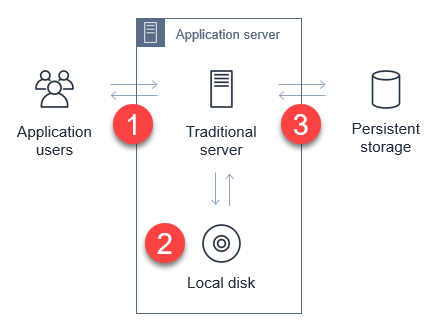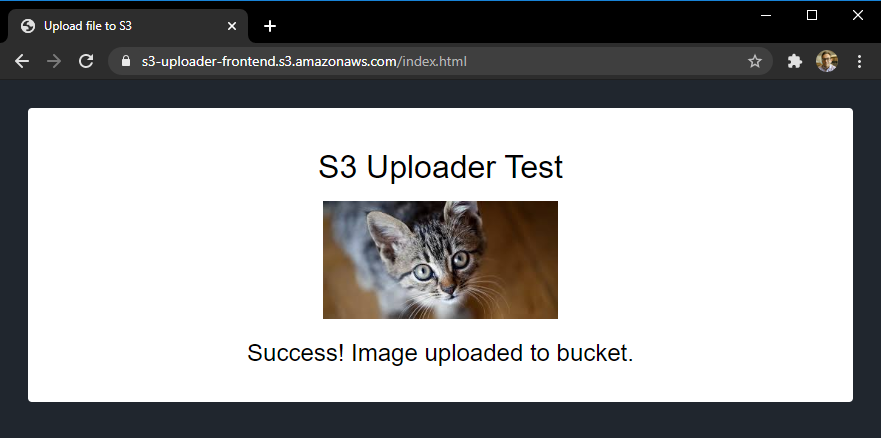File Upload Aws S3 Postman Api Document
In web and mobile applications, it's mutual to provide users with the ability to upload information. Your application may let users to upload PDFs and documents, or media such as photos or videos. Every modern web server technology has mechanisms to allow this functionality. Typically, in the server-based environment, the process follows this menstruum:

- The user uploads the file to the application server.
- The application server saves the upload to a temporary space for processing.
- The awarding transfers the file to a database, file server, or object store for persistent storage.
While the process is simple, it can have significant side-effects on the functioning of the web-server in busier applications. Media uploads are typically large, and then transferring these tin can represent a big share of network I/O and server CPU time. You must likewise manage the state of the transfer to ensure that the unabridged object is successfully uploaded, and manage retries and errors.
This is challenging for applications with spiky traffic patterns. For example, in a spider web awarding that specializes in sending holiday greetings, information technology may experience nigh traffic but around holidays. If thousands of users endeavor to upload media around the same time, this requires you to scale out the awarding server and ensure that there is sufficient network bandwidth available.
By directly uploading these files to Amazon S3, you can avoid proxying these requests through your application server. This tin can significantly reduce network traffic and server CPU usage, and enable your awarding server to handle other requests during decorated periods. S3 also is highly available and durable, making it an ideal persistent store for user uploads.
In this weblog post, I walk through how to implement serverless uploads and show the benefits of this approach. This pattern is used in the Happy Path web application. You tin download the code from this web log mail service in this GitHub repo.
Overview of serverless uploading to S3
When you upload direct to an S3 bucket, you must first request a signed URL from the Amazon S3 service. You can and so upload directly using the signed URL. This is ii-step process for your application forepart:

- Telephone call an Amazon API Gateway endpoint, which invokes the getSignedURL Lambda office. This gets a signed URL from the S3 saucepan.
- Directly upload the file from the application to the S3 bucket.
To deploy the S3 uploader example in your AWS business relationship:
- Navigate to the S3 uploader repo and install the prerequisites listed in the README.md.
- In a terminal window, run:
git clone https://github.com/aws-samples/amazon-s3-presigned-urls-aws-sam
cd amazon-s3-presigned-urls-aws-sam
sam deploy --guided
- At the prompts, enter s3uploader for Stack Proper name and select your preferred Region. In one case the deployment is complete, note the APIendpoint output.The API endpoint value is the base URL. The upload URL is the API endpoint with
/uploadsappended. For example:https://ab123345677.execute-api.united states-west-two.amazonaws.com/uploads.

Testing the application
I evidence 2 ways to test this application. The first is with Postman, which allows you to directly call the API and upload a binary file with the signed URL. The second is with a basic frontend application that demonstrates how to integrate the API.
To examination using Postman:
- Outset, copy the API endpoint from the output of the deployment.
- In the Postman interface, paste the API endpoint into the box labeled Enter request URL.
- Cull Transport.

- After the request is complete, the Body section shows a JSON response. The uploadURL attribute contains the signed URL. Copy this attribute to the clipboard.
- Select the + icon next to the tabs to create a new request.
- Using the dropdown, change the method from GET to PUT. Paste the URL into the Enter request URL box.
- Cull the Trunk tab, so the binary radio button.

- Choose Select file and choose a JPG file to upload.
Choose Transport. You see a 200 OK response after the file is uploaded.
- Navigate to the S3 console, and open up the S3 saucepan created by the deployment. In the saucepan, you lot see the JPG file uploaded via Postman.

To test with the sample frontend application:
- Copy alphabetize.html from the example's repo to an S3 bucket.
- Update the object's permissions to brand information technology publicly readable.
- In a browser, navigate to the public URL of alphabetize.html file.

- Select Choose file and then select a JPG file to upload in the file picker. Choose Upload image. When the upload completes, a confirmation bulletin is displayed.

- Navigate to the S3 console, and open up the S3 bucket created past the deployment. In the bucket, you lot run across the second JPG file you uploaded from the browser.

Understanding the S3 uploading process
When uploading objects to S3 from a web application, you must configure S3 for Cross-Origin Resources Sharing (CORS). CORS rules are defined as an XML document on the saucepan. Using AWS SAM, you can configure CORS as part of the resource definition in the AWS SAM template:
S3UploadBucket: Type: AWS::S3::Bucket Backdrop: CorsConfiguration: CorsRules: - AllowedHeaders: - "*" AllowedMethods: - GET - PUT - HEAD AllowedOrigins: - "*" The preceding policy allows all headers and origins – it's recommended that y'all use a more restrictive policy for production workloads.
In the first pace of the process, the API endpoint invokes the Lambda function to make the signed URL request. The Lambda function contains the post-obit code:
const AWS = require('aws-sdk') AWS.config.update({ region: process.env.AWS_REGION }) const s3 = new AWS.S3() const URL_EXPIRATION_SECONDS = 300 // Main Lambda entry indicate exports.handler = async (event) => { render await getUploadURL(consequence) } const getUploadURL = async function(result) { const randomID = parseInt(Math.random() * 10000000) const Cardinal = `${randomID}.jpg` // Go signed URL from S3 const s3Params = { Bucket: process.env.UploadBucket, Key, Expires: URL_EXPIRATION_SECONDS, ContentType: 'image/jpeg' } const uploadURL = expect s3.getSignedUrlPromise('putObject', s3Params) render JSON.stringify({ uploadURL: uploadURL, Fundamental }) } This role determines the name, or key, of the uploaded object, using a random number. The s3Params object defines the accepted content type and too specifies the expiration of the fundamental. In this instance, the key is valid for 300 seconds. The signed URL is returned as part of a JSON object including the key for the calling application.
The signed URL contains a security token with permissions to upload this single object to this bucket. To successfully generate this token, the code calling getSignedUrlPromise must take s3:putObject permissions for the bucket. This Lambda role is granted the S3WritePolicy policy to the bucket past the AWS SAM template.
The uploaded object must match the aforementioned file name and content type equally defined in the parameters. An object matching the parameters may be uploaded multiple times, providing that the upload process starts before the token expires. The default expiration is 15 minutes but yous may desire to specify shorter expirations depending upon your use case.
Once the frontend application receives the API endpoint response, it has the signed URL. The frontend application so uses the PUT method to upload binary information straight to the signed URL:
allow blobData = new Blob([new Uint8Array(assortment)], {blazon: 'image/jpeg'}) const consequence = expect fetch(signedURL, { method: 'PUT', trunk: blobData }) At this point, the caller application is interacting directly with the S3 service and not with your API endpoint or Lambda function. S3 returns a 200 HTML condition code once the upload is consummate.
For applications expecting a large number of user uploads, this provides a simple way to offload a big amount of network traffic to S3, away from your backend infrastructure.
Adding authentication to the upload process
The electric current API endpoint is open up, available to any service on the internet. This means that anyone can upload a JPG file once they receive the signed URL. In most production systems, developers desire to utilise authentication to control who has access to the API, and who can upload files to your S3 buckets.
Y'all can restrict access to this API by using an authorizer. This sample uses HTTP APIs, which support JWT authorizers. This allows you lot to control access to the API via an identity provider, which could be a service such as Amazon Cognito or Auth0.
The Happy Path application just allows signed-in users to upload files, using Auth0 as the identity provider. The sample repo contains a 2nd AWS SAM template, templateWithAuth.yaml, which shows how yous can add an authorizer to the API:
MyApi: Blazon: AWS::Serverless::HttpApi Backdrop: Auth: Authorizers: MyAuthorizer: JwtConfiguration: issuer: !Ref Auth0issuer audition: - https://auth0-jwt-authorizer IdentitySource: "$request.header.Dominance" DefaultAuthorizer: MyAuthorizer Both the issuer and audience attributes are provided past the Auth0 configuration. By specifying this authorizer as the default authorizer, it is used automatically for all routes using this API. Read office 1 of the Enquire Around Me series to learn more about configuring Auth0 and authorizers with HTTP APIs.
After authentication is added, the calling web application provides a JWT token in the headers of the asking:
const response = expect axios.get(API_ENDPOINT_URL, { headers: { Authorisation: `Bearer ${token}` } }) API Gateway evaluates this token before invoking the getUploadURL Lambda function. This ensures that but authenticated users tin upload objects to the S3 saucepan.
Modifying ACLs and creating publicly readable objects
In the current implementation, the uploaded object is not publicly accessible. To make an uploaded object publicly readable, you must set its admission command listing (ACL). There are preconfigured ACLs available in S3, including a public-read option, which makes an object readable past anyone on the internet. Fix the appropriate ACL in the params object before calling s3.getSignedUrl:
const s3Params = { Saucepan: process.env.UploadBucket, Key, Expires: URL_EXPIRATION_SECONDS, ContentType: 'image/jpeg', ACL: 'public-read' } Since the Lambda role must have the advisable bucket permissions to sign the request, you must likewise ensure that the function has PutObjectAcl permission. In AWS SAM, you can add the permission to the Lambda role with this policy:
- Statement: - Effect: Allow Resource: !Sub 'arn:aws:s3:::${S3UploadBucket}/' Action: - s3:putObjectAcl Decision
Many web and mobile applications allow users to upload information, including large media files similar images and videos. In a traditional server-based application, this tin can create heavy load on the application server, and too use a considerable amount of network bandwidth.
By enabling users to upload files to Amazon S3, this serverless blueprint moves the network load abroad from your service. This can make your awarding much more scalable, and capable of handling spiky traffic.
This blog mail walks through a sample awarding repo and explains the process for retrieving a signed URL from S3. It explains how to the test the URLs in both Postman and in a web application. Finally, I explain how to add together authentication and brand uploaded objects publicly attainable.
To larn more, see this video walkthrough that shows how to upload directly to S3 from a frontend spider web application. For more serverless learning resources, visit https://serverlessland.com.
Source: https://aws.amazon.com/blogs/compute/uploading-to-amazon-s3-directly-from-a-web-or-mobile-application/
0 Response to "File Upload Aws S3 Postman Api Document"
Post a Comment